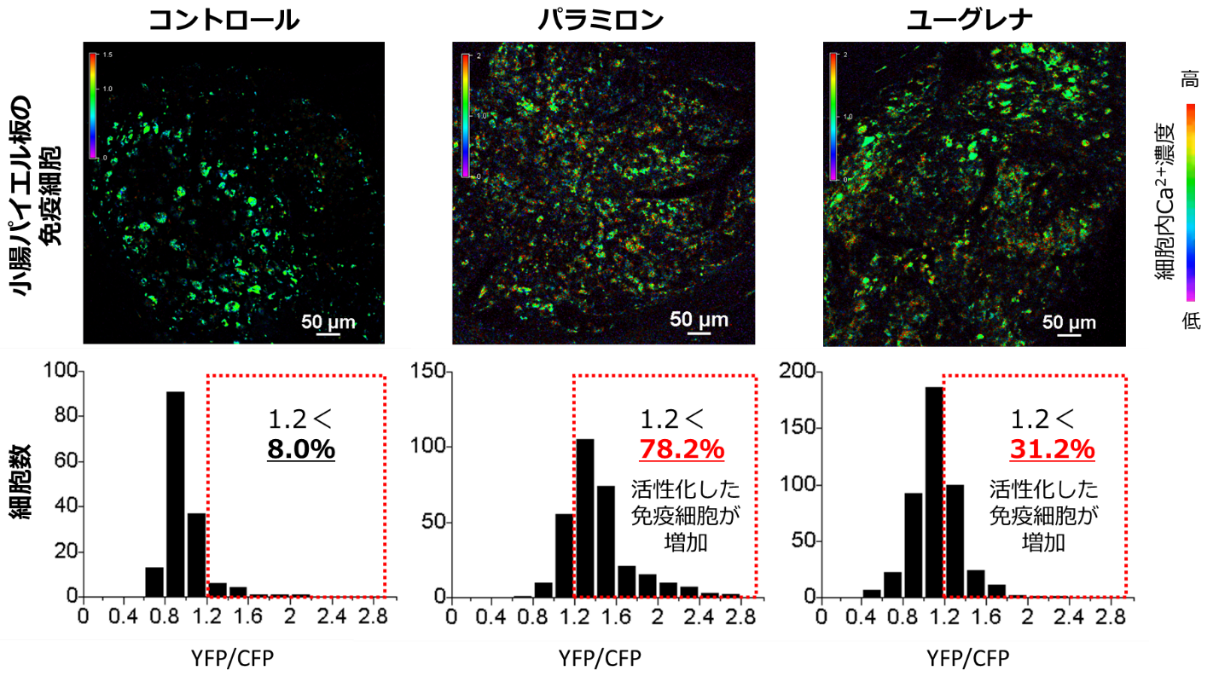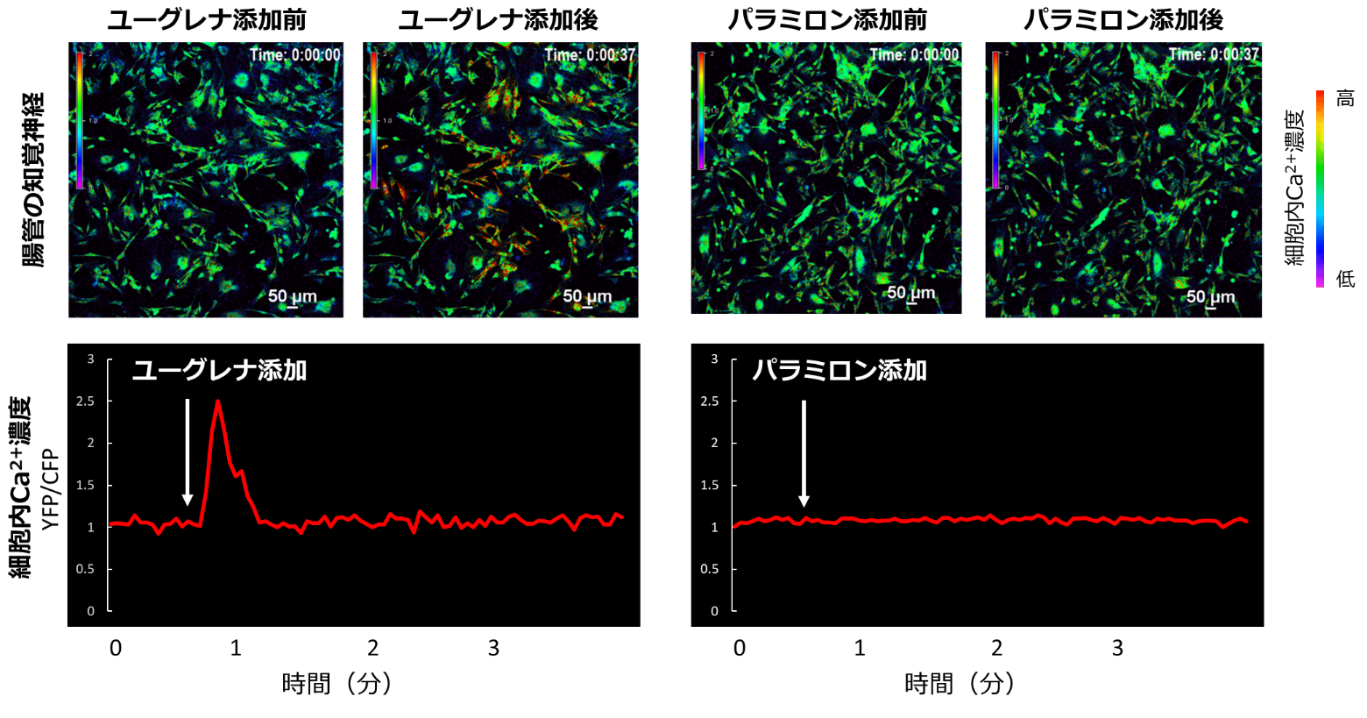Press Releases
* Please note that the news release contains the content at the time of the announcement and may differ from the latest information.
Confirmed research results suggesting that the microalgae Euglena and the unique component paramylon act on immune cells and nerve cells
Euglena Co., Ltd.
Euglena Co., Ltd. (Headquarters: Minato-ku, Tokyo, President: Mitsuru Izumo) has collaborated with Associate Professor Takahiro Adachi of Tokyo Medical and Dental University to collaborate with the microalga Euglena (Japanese name: Euglena, hereinafter "Euglena") and its peculiarities. By observing the effects of the component paramylon in the intestinal tract in real time, we confirmed the research results suggesting that it acts on immune cells and nerve cells as a food signal * 1.
The results of this research were announced at the "Japan Society for Bioscience and Biotechnology 2020 Conference" (held from March 25 to 28 * 2) and were selected as excellent presentations.
* 1 A food ingredient that activates intracellular signal transduction. The intracellular calcium concentration is used as an index.
* 2 The Japan Society for Bioscience and Biotechnology 2020 Convention will be held in light of the government's announcement on February 26, "The idea of requesting cancellation, postponement, or reduction of the scale of large-scale sports and cultural events." Although the event program has been canceled, the announcement is considered to have been completed by posting the conference lecture abstracts on the conference website.
https://www.jsbba.or.jp/2020/
■ Purpose of research
The intestinal tract is an organ that not only absorbs food nutrients but also protects pathogens and gathers more than half of the peripheral nerves, and plays an important role in maintaining homeostasis of the living body. We have previously reported that continuous intake of paramylon may maintain immune balance and prevent the onset of disease * 3, and that Euglena effectively contributes to the state of the brain * 4. increase.
Euglena and paramylon are recognized in the intestinal tract in order to consider the mechanism of action of these effects. Specifically, as an index a change in calcium (hereinafter Ca 2+) concentration involved in intracellular signal transduction, Euglena and paramylon is, sensory neurons of dendritic cells ※ 5 and ② intestine which is a kind of ① immune cells I confirmed the effect on.
* 3 Released on April 17, 2014 https://www.euglena.jp/news/n20140417/
* 4 Released on May 28, 2019 https://www.euglena.jp/news/20190528/
* 5 A type of immune cell, a cell that takes in and decomposes invading foreign substances and issues commands to activate other immune cells.
■ Research content and results
(1) Euglena and paramylon have been suggested to act on immune cells
Calcium biosensor * 6 Small intestinal Peyer's patch using genetically modified mice expressed in dendritic cells, a type of immune cell * 7 Intracellular Ca of dendritic cells localized in 2+ The change in concentration was observed (Fig. 1). Euglena and paramylon causes Ca in dendritic cells localized in Peyer's patches of the small intestine. 2+ An increase in concentration was confirmed, which was more strongly confirmed with paramylon than Euglena This suggests Euglena acts on immune cells as a major component involved.
* 6 The calcium biosensor Yellow Cameleon 3.60 (YC3.60)) has a cyan fluorescent protein (CFP) and a yellow fluorescent protein (YFP) in one molecule, and causes structural changes depending on calcium to cause two fluorescent proteins. Fluorescence changes from cyan to yellow due to fluorescence resonance energy transfer when only CFP is excited. YC3.60 is intracellular Ca due to the ratio of the fluorescence intensities of the two fluorescent proteins (YFP / CFP). 2+ A biosensor that can monitor the concentration of intracellular Ca, which is used as a second messenger when various information is transmitted in nerve cells and immune cells. 2+ It is possible to visualize the change in the concentration of.
* 7 Peyer's patches localized in the small intestine are peripheral lymphoid tissues in which lymphocytes and dendritic cells accumulate.

Figure 1: Changes in Ca 2+ concentration in immune cells of Peyer's patches of the small intestine
* When the number of immune cells whose intracellular Ca 2+ concentration increased after administration of Euglena was examined, 78.9% of the total immune cells were activated by paramylon and 31.2% of the total immune cells were activated by Euglena
(2) Euglena acts on the sensory nerves of the intestinal tract.
Using nerve cells * 8 derived from the dorsal root ganglion collected from genetically modified mice in which a calcium biosensor was expressed in nerve cells, changes in intracellular Ca 2+ concentration of sensory nerve cells were confirmed (Fig. 2). Addition Euglena to sensory nerve cells was confirmed to increase Ca 2+ concentration. On the other hand, when paramylon was added, no change in Ca 2+ concentration was observed. This Euglena act on the sensory nerves of the intestinal tract.
* 8 The dorsal root ganglion is a group of nerve cells that function as a relay point for sensory information from the periphery.

Figure 2: Changes in Ca 2+ concentration in sensory neurons in the intestinal tract
* Cells with increased intracellular Ca 2+ concentration were confirmed when Euglena
<About microalgae Euglena (Japanese name: Euglena)>
Euglena (Japanese name: Midorimushi) is a type of algae similar to wakame seaweed, kelp, and chlorella. It has the characteristics of both animals and plants, and has 59 types of vitamins, minerals, amino acids, unsaturated fatty acids, etc. Contains well-balanced nutrients. Paramylon, which is a component unique to Euglena and is a type of β-glucan, has been studied for its functionality in recent years and is expected to be used in the healthcare field such as foods and cosmetics. The "Euglena for the body" series, which includes Euglena, captures the facts of the interrelationships of "malnutrition," "mental and physical fatigue," and "immunity weakness," and focuses on complex factors that hinder the foundation of health. doing. It is important to achieve sustainable health, not temporary, by maintaining the body's original cycle of "creating, working, and protecting" and improving it to a better state, regardless of factors that hinder the foundation of health. I think.
<About Euglena Co., Ltd.>
In 2005, we succeeded in establishing the world's first edible outdoor mass culture technology for the Euglena In addition to developing and selling functional foods and cosmetics that utilize the Euglena and Chlorella produced on Ishigaki Island, we are also conducting research toward the production of biofuels. Listed on TSE Mothers in December 2012. TSE First Section market change in December 2014. The management philosophy is "to make people and the earth healthy". https://euglena.jp
-Contact for inquiries from the press-
Euglena Co., Ltd. Corporate Communication Division
